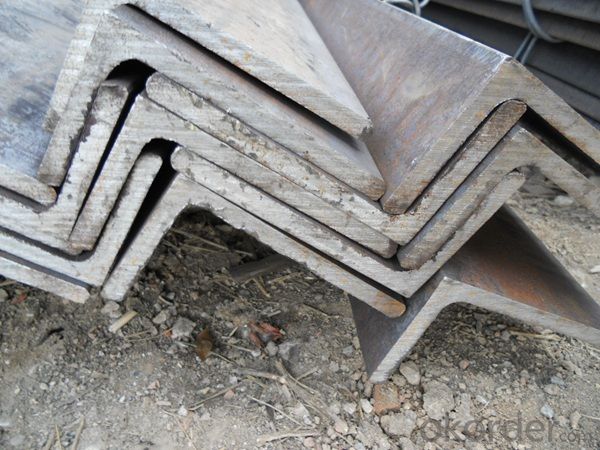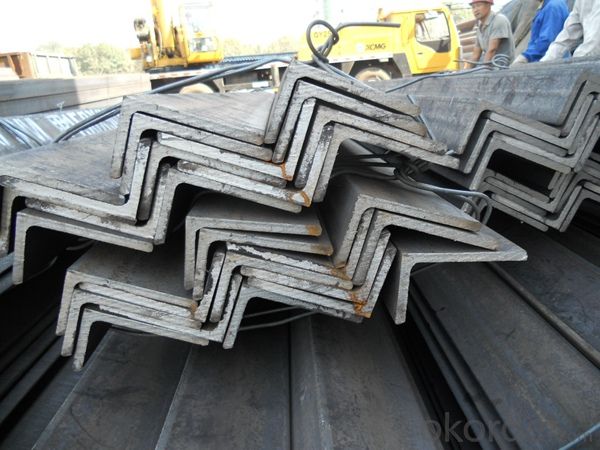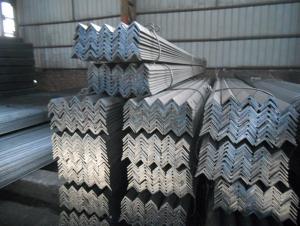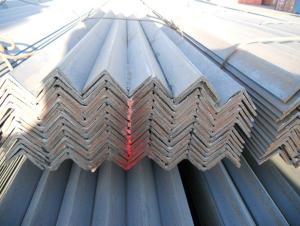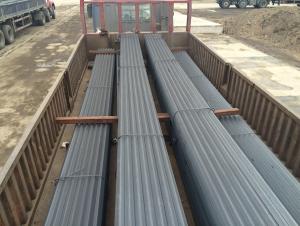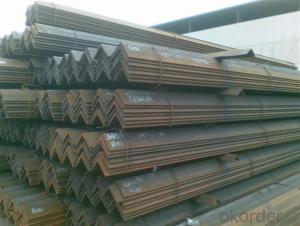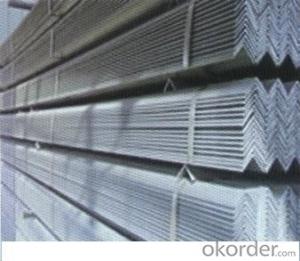Q345B angle, angle steel, galvanized angle steel
- Loading Port:
- Tianjin
- Payment Terms:
- TT or LC
- Min Order Qty:
- 25 m.t
- Supply Capability:
- 1000 m.t/month
OKorder Service Pledge
OKorder Financial Service
You Might Also Like
Specification
Product Description:
OKorder is offering Q345B angle, angle steel, galvanized angle steelat great prices with worldwide shipping. Our supplier is a world-class manufacturer of steel, with our products utilized the world over. OKorder annually supplies products to European, North American and Asian markets. We provide quotations within 24 hours of receiving an inquiry and guarantee competitive prices.
Product Applications:
Q345B angle, angle steel, galvanized angle steel are ideal for structural applications and are widely used in the construction of buildings and bridges, and the manufacturing, petrochemical, and transportation industries.
Product Advantages:
OKorder's Q345B Small angle, angle steel, galvanized angle steel are durable, strong, and resist corrosion.
Main Product Features:
· Premium quality
· Prompt delivery & seaworthy packing (30 days after receiving deposit)
· Corrosion resistance
· Can be recycled and reused
· Mill test certification
· Professional Service
· Competitive pricing
Product Description:
Angle called angle, the steel strip is perpendicular to each other on both sides into angular.Divided into equilateral angle steel and ranging from side angle. Two equilateral angle steel edge width is the same. The specification is expressed by edge width * width * thick edgenumber of millimeters. Such as "/ 30 x 30 x 3", namely that equilateral angle steel edge widthof 30 mm, 3 mm thick edge. Can also be used to model representation, model is the wideangle 3# cm, such as. The model does not represent the same type in different edge thickness size, thus in the contract and other documents on the angle of the edge width, edgethick size fill in complete, avoid alone represented by type. Hot rolled equilateral angle steelspecifications for 2#-20#. Angle according to the different needs of structure composed of a variety of stress components, can also be used as a component of the connections between the. Widely used in a variety of architectural and engineering structures, such as beams,bridges, towers, hoisting and conveying machinery, ships, industrial furnace, reactor,container frame and warehouse.
Mainly divided into equilateral angle steel, equilateral angle steel two categories, includingunequal angle can be divided into equal thickness and unequal thickness ranging from two.
Angle specifications with the side length of the size and edge thickness. At present, the domestic steel specifications for 2 - 20 cm in length, number of numbers, the same horn steel often have 2 - 7 different edge thickness. The actual size and inlet angle marked on both sides of the thickness and indicate the relevant standards. The general length of more than 312.5px for large angle steel, 312.5px - 125px for the medium angle, length of 125px for smallangle.
Inlet and outlet angle steel orders generally required the use specifications in the steel,carbon structural steel grades as appropriate. Is the angle in addition to standard number, nospecific composition and performance series.
Angle steel delivery length is divided into fixed length, size two, domestic steel length range is3 - 9m, 4 12M, 4 19m, 6 19m four range according to different specifications. Japanese steellength ranges from 6 to 15m.
Section of unequal angle height according to the long edge of the width to calculate the non equilateral angle steel. Refer to section angle and side length is not equal to the steel. Is a kind of angle steel. The length from 25mm * 16mm to 200mm * l25mm. By the hot rolling mill rolling in. General scalene angle steel specifications: thickness of 4-18mm / 50*32-- / 200*125
Equilateral angle steel is widely used in all kinds of metal structures, bridges, machinery manufacturing and shipbuilding industry, all kinds of architectural and engineering structures,such as beams, bridges, towers, hoisting and conveying machinery, ships, industrial furnace,reactor, container frame and warehouse etc.
FAQ:
Q1: Why buy Materials & Equipment from OKorder.com?
A1: All products offered byOKorder.com are carefully selected from China's most reliable manufacturing enterprises. Through its ISO certifications, OKorder.com adheres to the highest standards and a commitment to supply chain safety and customer satisfaction.
Q2: How do we guarantee the quality of our products?
A2: We have established an advanced quality management system which conducts strict quality tests at every step, from raw materials to the final product. At the same time, we provide extensive follow-up service assurances as required.
Q3: How soon can we receive the product after purchase?
A3: Within three days of placing an order, we will begin production. The specific shipping date is dependent upon international and government factors, but is typically 7 to 10 workdays.
Images:
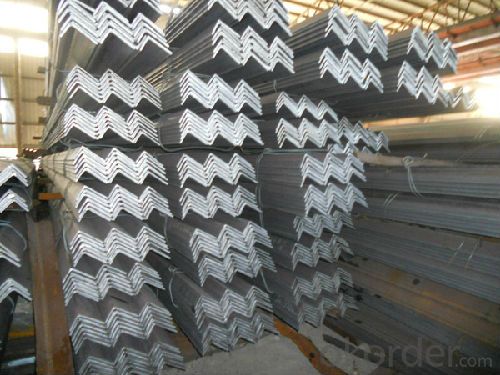
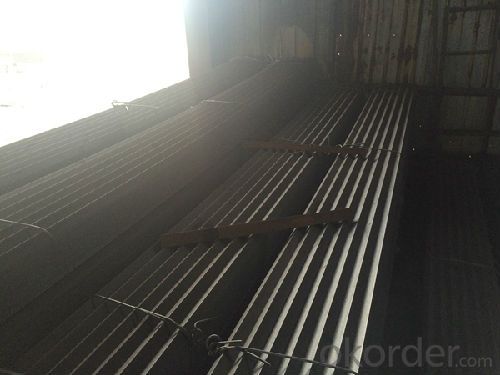
- Q: How do you design connections for steel angles?
- When designing connections for steel angles, several factors need to be considered to ensure structural integrity and safety. Here are the key steps in designing connections for steel angles: 1. Determine the load and forces: Understand the loads the connection will be subjected to, such as tension, compression, or shear forces. Calculate the magnitude and direction of these forces to accurately assess the connection's requirements. 2. Select the type of connection: Determine the appropriate connection type based on the forces involved, structural design, and aesthetic requirements. Common connection types for steel angles include bolted, welded, or a combination of both. 3. Size the angles: Determine the appropriate size of the steel angles based on the loads and forces. Consider the angle's cross-sectional shape, material strength, and desired safety factors to ensure it can withstand the applied loads. 4. Check for interaction effects: Assess any interaction effects between the connection and the structural members. Account for any changes in the behavior of the angles due to the connection, such as added stiffness or reduction in capacity. 5. Design the connection details: Once the connection type and angle size are determined, design the connection details. Consider factors like the number and size of bolts, welding specifications, edge distances, and spacing requirements. 6. Check for failure modes: Analyze the connection design for potential failure modes, such as bearing, tearing, or shearing. Ensure that the connection has adequate strength and ductility to resist these failure modes. 7. Perform calculations and analysis: Utilize appropriate engineering principles and standards to perform calculations and analysis on the connection design. Check for factors like static equilibrium, stress distribution, and load transfer to confirm the connection's adequacy. 8. Incorporate design codes and standards: Adhere to relevant design codes and standards, such as the American Institute of Steel Construction (AISC) Manual, to ensure compliance with industry best practices and safety requirements. 9. Consider constructability and ease of fabrication: While designing connections, consider the constructability and ease of fabrication. Aim for simplicity in connection details to facilitate efficient manufacturing and construction processes. 10. Review and revise: Finally, review the connection design and seek input from structural engineers or other experts. Revise the design as necessary based on their recommendations to optimize the connection's performance and efficiency. By following these steps, engineers can design connections for steel angles that effectively transfer forces, ensure structural stability, and meet safety requirements.
- Q: Can steel angles be used for structural applications?
- Yes, steel angles can be used for structural applications. They are commonly used in construction and engineering projects to provide structural support, stability, and reinforcement. Steel angles have excellent strength-to-weight ratio, high durability, and versatility, making them suitable for various structural applications such as framing, bracing, trusses, and supports.
- Q: Can steel angles be used in seismic-resistant structures?
- Yes, steel angles can be used in seismic-resistant structures. Steel angles are commonly used as structural elements in buildings and bridges due to their high strength and versatility. In seismic-resistant structures, steel angles can be utilized in various ways to enhance the overall structural integrity and resistance to earthquakes. Steel angles can be used as bracing elements in seismic-resistant structures. By connecting steel angles diagonally between different structural components, they can help to distribute and dissipate seismic forces, reducing the overall impact on the structure. This helps to prevent excessive deformation or collapse during an earthquake. Additionally, steel angles can be used to reinforce and strengthen key components of the structure. For example, they can be welded or bolted to the beams and columns to provide additional support and stiffness. This reinforcement helps to withstand the lateral forces generated by earthquakes, improving the overall seismic performance of the structure. Moreover, steel angles can be employed in the construction of moment-resisting frames, which are widely used in seismic-resistant structures. In these frames, steel angles are used as the main components to create rigid connections between beams and columns, allowing them to transfer and distribute seismic forces effectively. This design strategy helps to minimize structural damage and provides better resistance to earthquakes. It is important to note that the use of steel angles in seismic-resistant structures should comply with relevant building codes and regulations. The specific design and detailing requirements may vary depending on the seismic zone and the magnitude of potential earthquakes. Therefore, it is crucial to consult with structural engineers and adhere to the appropriate guidelines to ensure the safe and effective use of steel angles in seismic-resistant structures.
- Q: How do you design connections for steel angles to concrete?
- To design connections for steel angles to concrete, several factors need to be considered. Firstly, the load requirements and type of connection (such as shear, tension, or moment) must be determined. Then, appropriate connection methods like embedded plates, anchor bolts, or post-installed anchors can be selected. The design must also consider the concrete strength, angle size, spacing, and edge distances. Detailed calculations are performed to ensure the connection is safe and meets the applicable design codes and standards. Additionally, factors like corrosion protection and construction feasibility should be considered during the design process.
- Q: How do steel angles contribute to the overall stability of a building?
- Steel angles contribute to the overall stability of a building by providing structural support and reinforcement. They are commonly used to reinforce corners and joints in construction, helping to distribute the load and prevent the building from collapsing or experiencing excessive movement during strong winds, earthquakes, or other external forces. The angled shape of steel angles also helps to increase the rigidity and strength of the building's framework, enhancing its overall stability and durability.
- Q: How do you join two steel angles together?
- There are several methods available for joining two steel angles together, depending on the specific application and requirements. Here are a few commonly used techniques: 1. Welding: The most widely used method for joining steel angles is welding. This involves heating the joint to a high temperature and melting a compatible metal filler material to fuse the angles together. Welding creates a strong and permanent bond, but it requires specialized equipment and expertise, so it is usually carried out by trained professionals. 2. Bolting: Another option is to use bolts or screws to connect the steel angles. This involves drilling holes in both angles and securing them with appropriate fasteners. Bolting allows for easier disassembly and modification if necessary, but it may not offer the same level of strength as welding. 3. Riveting: Riveting is a technique that utilizes metal pins or bolts called rivets to hold the steel angles together. It involves drilling holes in the angles and inserting the rivets, which are then hammered or pressed to create a permanent joint. Riveting is commonly employed in structural applications where high strength and load-bearing capacity are essential. 4. Adhesive bonding: In certain cases, adhesive bonding can be used to join steel angles. Specialized adhesives are applied to the joint surfaces, and then the angles are pressed together and left to cure. This method can result in a clean and visually appealing bond, although it may not possess the same strength as other mechanical methods. When choosing a method to join steel angles, it is crucial to consider factors such as load-bearing requirements, structural integrity, accessibility, and the specific conditions of the application. Consulting with a structural engineer or a professional in the field can help determine the most suitable technique for your particular needs.
- Q: What are the different types of steel angles used in fencing and gates?
- Fencing and gates commonly utilize several types of steel angles. An example is the equal angle, also known as the L-shaped angle, which has sides of equal length. It is frequently employed for vertical and horizontal bracing in fencing and gates. Another variant is the unequal angle, which features one longer side and one shorter side. This type is often used for diagonal bracing, providing added strength and stability to fencing and gates. The rounded edge angle is another option, replacing sharp corners with rounded edges. This choice is favored in fencing and gates to minimize the risk of injury, as the rounded edges are less likely to cause cuts or other accidents. Additionally, there are slotted angles that come with pre-drilled holes along their length. These holes facilitate the easy attachment of fencing and gate components such as panels or hinges. Finally, galvanized angles are coated with a layer of zinc to safeguard against rust and corrosion. This type is particularly suitable for outdoor fencing and gates, offering long-lasting durability and resistance to the elements. In conclusion, the various types of steel angles used in fencing and gates provide different advantages in terms of strength, stability, safety, ease of installation, and resistance to rust and corrosion. The choice of angle will depend on the specific requirements and preferences of each fencing or gate project.
- Q: How can the angle iron tripod be welded or not?
- Angle called angle, the steel strip is perpendicular to each other on both sides into the corner. There are equal angles and unequal angles. The two sides of an equal angle steel are equal in width.
- Q: What are the different methods of connecting steel angles together?
- There are several methods of connecting steel angles together, including welding, bolting, riveting, and using angle brackets.
- Q: Are steel angles suitable for coastal or saltwater environments?
- Steel angles can indeed be used in coastal or saltwater environments, but it is essential to consider the steel type and implement proper protection measures for durability and resistance against corrosion. Stainless steel angles, especially those made from marine grade stainless steel like 316 or 316L, are highly regarded for their outstanding resistance to corrosion in saltwater environments. These angles contain higher levels of chromium and molybdenum, which offer superior protection against rust and corrosion caused by exposure to saltwater and other harsh elements. Moreover, additional protective coatings or treatments such as galvanization or epoxy coating can be applied to steel angles to further enhance their resistance to corrosion in coastal or saltwater settings. These coatings establish a barrier between the steel and the corrosive elements, preventing direct contact and reducing the risk of rust or corrosion. To determine the most appropriate steel type and protective measures for a specific project in coastal or saltwater areas, it is crucial to consult with structural engineers, architects, or steel suppliers who specialize in such applications. Regular maintenance and inspections play a vital role in promptly identifying any signs of corrosion or damage and addressing them to ensure the longevity and safety of steel angles in coastal or saltwater environments.
Send your message to us
Q345B angle, angle steel, galvanized angle steel
- Loading Port:
- Tianjin
- Payment Terms:
- TT or LC
- Min Order Qty:
- 25 m.t
- Supply Capability:
- 1000 m.t/month
OKorder Service Pledge
OKorder Financial Service
Similar products
Hot products
Hot Searches
Related keywords




